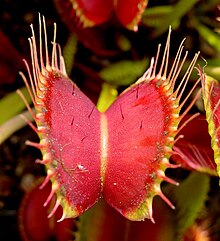Venus flytraps
| Venus flytrap | |
|---|---|
 |
|
| Leaf | |
| Scientific classification | |
| Kingdom: | Plantae |
| Clade: | Angiosperms |
| Clade: | Eudicots |
| Order: | Caryophyllales |
| Family: | Droseraceae |
| Genus: |
Dionaea Sol. ex J.Ellis 1768 |
| Species: | D. muscipula |
| Binomial name | |
|
Dionaea muscipula J.Ellis |
|
 |
|
| Distribution | |
| Synonyms | |
|
|
The Venus flytrap (also referred to as Venus's flytrap or Venus' flytrap), Dionaea muscipula, is a carnivorous plant native to subtropical wetlands on the East Coast of the United States in North Carolina and South Carolina. It catches its prey—chiefly insects and arachnids—with a trapping structure formed by the terminal portion of each of the plant's leaves, which is triggered by tiny hairs on their inner surfaces. When an insect or spider crawling along the leaves contacts a hair, the trap prepares to close, snapping shut only if another contact occurs within approximately twenty seconds of the first strike. The requirement of redundant triggering in this mechanism serves as a safeguard against wasting energy by trapping objects with no nutritional value, and the plant will only begin digestion after five more stimuli to ensure it has caught a live bug worthy of consumption.
Dionaea is a monotypic genus closely related to the waterwheel plant (Aldrovanda vesiculosa) and sundews (Drosera), all of which belong to the family Droseraceae.
In 1759, the North Carolina colonial governor, Arthur Dobbs, penned the first written description of the plant to English botanist Peter Collinson. Brunswick, Jan. 24, 1760.
“The great wonder of the vegetable kingdom is a very curious unknown species of Sensitive. It is a dwarf plant. The leaves are like a narrow segment of a sphere, consisting of two parts, like the cap of a spring purse, the concave part outwards, each of which falls back with indented edges (like an iron spring fox-trap); upon anything touching the leaves, or falling between them, they instantly close like a spring trap, and confine any insect or anything that falls between them. It bears a white flower. To this surprising plant I have given the name of Fly-trap Sensitive.”
...
Wikipedia

